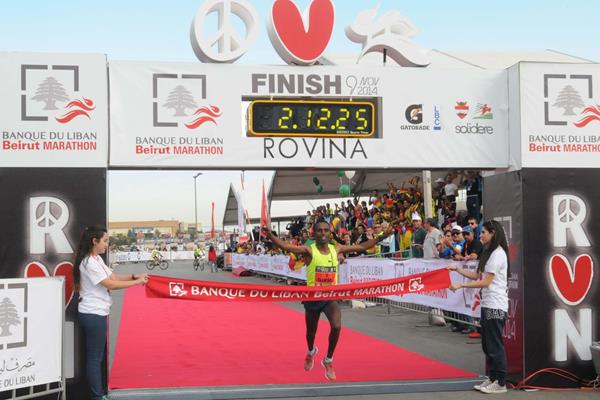 Ethiopia’s Fikadu Girma and Mulahabt Tsega triumphed at the 2014 Banque du Liban Beirut Marathon, winning at the IAAF Bronze Label Road Race in 2:12:26 and 2:29:15 respectively on Sunday (9).
Ethiopia’s Fikadu Girma and Mulahabt Tsega triumphed at the 2014 Banque du Liban Beirut Marathon, winning at the IAAF Bronze Label Road Race in 2:12:26 and 2:29:15 respectively on Sunday (9).Girma, in just his second marathon after finishing third in 2:09:34 at the Dusseldorf Marathon earlier this year, clocked the second fastest winning time in the Beirut Marathon’s 12-year history, while Tsega took more than two minutes off the former course record of 2:31:38, set by her compatriot Seada Kedir in 2011, in what will have been a highly satisfying debut over the classic distance, especially in the warm conditions.
In the men’s race, a three-man all-Ethiopian trio of Girma, Abdela Godana and Legese Adungna went through 20km in 1:01:53 with Morocco’s Mohammed Blal and another Ethiopian Damte Taye just 20 metres in arrears, giving rise to hopes that the course record of 2:11:14, that had belonged to Ethiopia’s Tariku Jufar since 2011, might fall.
By 30km, passed in 1:33:17, with Girma and Godana running together at the front and Blal 24 seconds adrift of the leading pair, Jufar’s mark was still in their sights.
However, gradually the pace started to slacken although Godana did manage to pull away from his compatriot Girma, who was unwell between kilometres 32 and 33, and went through 35km in 1:49:09 with a 15-second lead over Girma.
It soon became apparent that possibility of the course record was starting to seriously ebb away and that both men were concentrating their own race rather than having a duel with the clock, as Girma gradually recovered from his stomach problem and reeled his countryman at 38km, before decisively pulling away from him.
Godana hung on to finish second in 2:13:28 while Adungna, who went through a bad patch between 28 and 30 kilometres, came through strongly in the final 10km to finish third in 2:17:31.
Tsega makes impressive marathon debut
In the women’s race, Ethopia's pre-race favourite Zemzem Ahmed dropped out at about 10km but four women - Tsega, Kenya’s Monica Jepkoech, two-time former winner Kedir and a third Ethiopian Makida Abdela - went through 20km together in 1:11:11 but from 25km onwards Tsega and Koech started to put daylight between themselves and the other two.
Tsega and Jepkoech were still together at 30km, reached in 1:46:30, but from 34km onwards Tsega started to drop her Kenyan rival.
The Ethiopian passed 35km in 2:04:00, 18 seconds ahead of Jepkoech and just continued to increase her lead over the final kilometres.
Jepkoech eventually finished second in 2:30:53. Although more than a minute behind the winner, she was also inside the old course record and took more than two minutes off her personal best.
Kedir, after winning in 2011 And 2012, had to settle for third on this occasion in 2:34:24.
As a guest of honour, Ethiopian distance running legend and former marathon world record holder Haile Gebrselassie was the official race starter.
Organisers estimated there were approximately 37,500 participants in the marathon and a variety other races staged on Sunday, with runners from 94 different countries having registered.
Phil Minshull and organisers for the IAAF
































